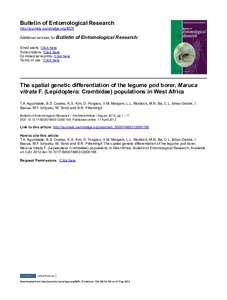| dc.contributor.author | Agunbiade, T.A. |
| dc.contributor.author | Coates, B.S. |
| dc.contributor.author | Kim, S.K. |
| dc.contributor.author | Forgacs, D. |
| dc.contributor.author | Margam, V.M. |
| dc.contributor.author | Murdock, L.L. |
| dc.contributor.author | Ba, Malick N. |
| dc.contributor.author | Binso-Dabire, L. |
| dc.contributor.author | Baoua, I. |
| dc.contributor.author | Ishiyaku, M. |
| dc.contributor.author | Tamo, M. |
| dc.contributor.author | Pittendrigh, Barry R. |
| dc.date.accessioned | 2019-12-04T11:07:47Z |
| dc.date.available | 2019-12-04T11:07:47Z |
| dc.date.issued | 2012-10 |
| dc.identifier.citation | Agunbiade, T., Coates, B.S., Kim, K.S., Forgacs, D., Margam, V.M., Murdock, L.L., ... & Tamò, M. (2012). The spatial genetic differentiation of the legume pod borer, Maruca vitrata F.(Lepidoptera: Crambidae) populations in West Africa. Bulletin of Entomological Research, 102(05), 589-599. |
| dc.identifier.issn | 0007-4853 |
| dc.identifier.uri | https://hdl.handle.net/20.500.12478/1585 |
| dc.description.abstract | The legume pod borer, Maruca vitrata, is an endemic insect pest that causes significant yield loss to the cowpea crop in West Africa. The application of population genetic tools is important in the management of insect pests but such data on M. vitrata is lacking. We applied a set of six microsatellite markers to assess the population structure of M. vitrata collected at five sites from Burkina Faso, Niger and Nigeria. Observed polymorphisms ranged from one (marker 3393) to eight (marker 32008) alleles per locus. Observed and expected heterozygosities ranged from 0.0 to 0.8 and 0.0 to 0.6, respectively. Three of the loci in samples from Nigeria and Burkina
Faso deviated significantly from Hardy-Weinberg Equilibrium (HWE), whereas no loci deviated significantly in samples from Niger. Analysis of molecular variance (AMOVA) indicated that 67.3% level of the genetic variation was within individuals compared to 17.3% among populations. A global estimate of FST=0.1 (ENA corrected FST=0.1) was significant (P≤0.05) and corroborated by pairwise FST values that were significant among all possible comparisons. A significant correlation was predicted between genetic divergence and geographic distance between subpopulations (R2=0.6, P=0.04), and cluster analysis by the program STRUCTURE predicted that co-ancestry of genotypes were indicative of three distinct populations. The spatialgenetic variance among M. vitrata in West Africa may be due to limited gene flow, south-north seasonal movement pattern or other reproductive barriers. This information is important for the cultural, chemical and biological control strategies for managing M. vitrata. |
| dc.language.iso | en |
| dc.subject | Microsatellites |
| dc.subject | Cowpea Pests |
| dc.title | The spatial genetic differentiation of the legume pod borer, Maruca vitrata F. (Lepidoptera: Crambidae) populations in West Africa |
| dc.type | Journal Article |
| dc.description.version | Peer Review |
| cg.contributor.crp | Grain Legumes |
| cg.contributor.affiliation | University of Illinois |
| cg.contributor.affiliation | United States Department of Agriculture |
| cg.contributor.affiliation | Seoul National University |
| cg.contributor.affiliation | King Abdullah University of Science and Technology |
| cg.contributor.affiliation | Purdue University |
| cg.contributor.affiliation | Ahmadu Bello University |
| cg.contributor.affiliation | International Institute of Tropical Agriculture |
| cg.coverage.region | Africa |
| cg.coverage.region | West Africa |
| cg.coverage.country | Nigeria |
| cg.coverage.country | Niger |
| cg.isijournal | ISI Journal |
| cg.authorship.types | CGIAR and developing country institute |
| cg.iitasubject | Grain Legumes |
| cg.iitasubject | Cowpea |
| cg.iitasubject | Plant Genetic Resources |
| cg.iitasubject | Genetic Improvement |
| cg.iitasubject | Pests Of Plants |
| cg.journal | Bulletin of Entomological Research |
| cg.howpublished | Formally Published |
| cg.accessibilitystatus | Limited Access |
| local.dspaceid | 82146 |
| cg.identifier.doi | https://dx.doi.org/10.1017/S0007485312000156 |

